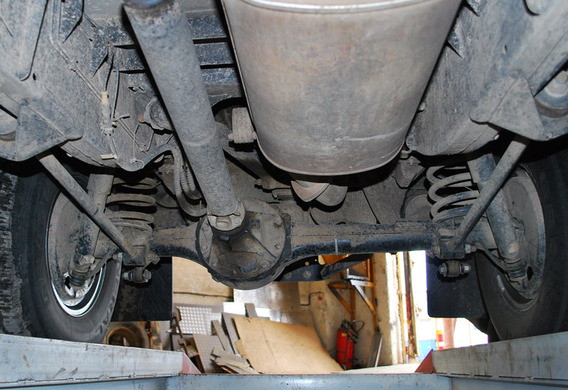
The dependent suspension is one of the oldest types of suspension connecting the wheels with the body of the car. In the dependent suspension, two wheels on the same axis are tightly coupled. History of the dependent suspension
History of the dependent suspension
The dependent suspension of the wheels was still used in combat chariots, carriages and simply carts. In their construction you can see simple and sometimes not very, dependent suspension. For example, the wheels of the cart were hulking on a wooden beam and not directly fixed to the cart.
In the first decades of the development of car industry, a very simple and cheap independent suspension was used very widely. As the maximum speed grew, it was tried to improve, but it soon became clear that the constructive resource of the dependent suspension had been exhausted and, in our time, its application was less frequent.
Dependent type types
To date, two main types of dependent suspension are applied: longitudinal springs and levers.
Dependent suspension on longitudinal springs
The suspension is a design in which the rigid beam of the bridge is attached to two longitudinal springs attached to the body or frame. The springs itself are composed of one or more metal sheets connected to each other. The springs to the body shall be refouted to the body with the help of special scamps (s). The springs are located along the body to withstand the effects of forces in three directions: in the longitudinal, vertical and lateral directions. It turns out that in the system of the dependent suspension, the longitudinal springs act as the elastic and steering element at the same time, as opposed to the spring, which only works on elasticity.
At high speed, the dependent suspension on the longitudinal springs is relatively weak against lateral forces. If you break up the car on the spring suspension, the bridge is shifting too far away, and the driveability of the car is getting worse. This is why in modern cars the dependent suspension on longitudinal springs in the classical form is hardly used.
Dependent suspension with guided levers
This type is a multi-lever construction, longitudinal and transverse. One side is fixed on the beam of the bridge and the other side is fixed on the frame or body of the car. The levers, as well as the springs, are designed to withstand vertical, lateral and longitudinal efforts. The role of the elastic element is performed by a twisted spring, and the shock absorbers the shock absorber.
As of today, the most frequently used is a dependent suspended suspension with 5 levers-4 longitudinal and 1 transverse.
The pepper lever does not give the axis of the car when it moves too far. He's got a name for Panara's rod, in honor of the French company Panhard.
In addition to the Panama-hard drive, the more sophisticated transverse lever, known as the Watt engine, is used. It is assembled from two horizontal levers attached to the third, vertical lever, which is attached to the centre of the beam of the bridge and can rotate. Panar's thrust has its own shortcomings. For example, during rotation it works unevenly, that is, at some point on the back of the body, it is better, in some way worse. In the Watt-mechanism systems, this is offset by the rotation of the vertical lever.
There is another device, often used in the construction of the addicted suspension mechanism, Scot-Russell. It uses two levers instead of one Pan's thrust, short and long. In this design, driveability and stability of the car are improved as long arm is attached to the beam by an elastic connection and preserves the ability of limited deflection.
An even more progressive type of add-ons is a system devised by the Count de Dion. It uses the same spring-loaded, uncarved beam, but has the ability to bend. De Dion can be called a semi-dependent type of suspension. It has not been widely distributed simply because it is necessary to use expensive materials to create a beam. However, serial cars with such suspension meet, and the most famous of them is a miniature Smart.
Advantages and disadvantages of the dependent suspension
The undoubted advantage of the dependent suspension is high strength and resistance to damage. In addition, its structure is simple and therefore not easy and cheap to operate. The drawbacks are the presence of large unbroken masses, that is, speaking simpler, it is heavy on its own. In addition, cars with dependent suspension are slightly worse managed and have lower exchange rate stability. In cars with a dependent suspension it is more difficult to achieve a high degree of comfort and more "shaking".
The dependent suspension is the best solution to create an SUV. However, it is necessary to accept the loss of opportunity to maneuver in the city and at a relatively low speed. However, in off-road conditions, even if the damage is seriously damaged, the car does not lose the opportunity to move. There have been cases in which movement has continued even with a bent bridge.
A dependent suspension on the right can be proud of the title of veteran auto industry. The principles of its design used on the very first cars are used to this day in classic Jeep, Nissan SUVs and, of course, UAZ.









